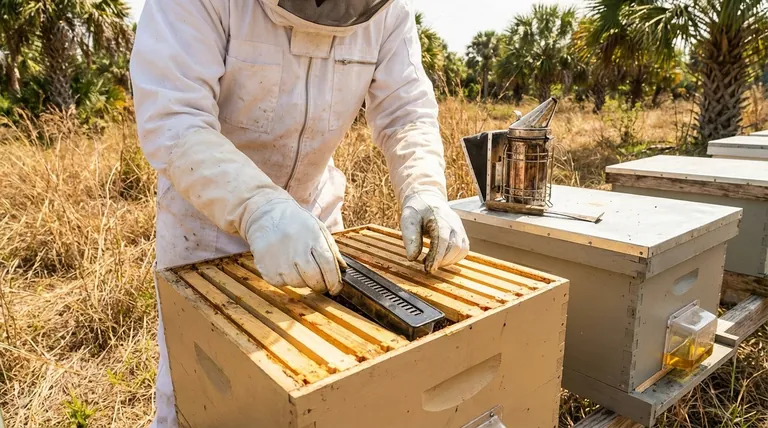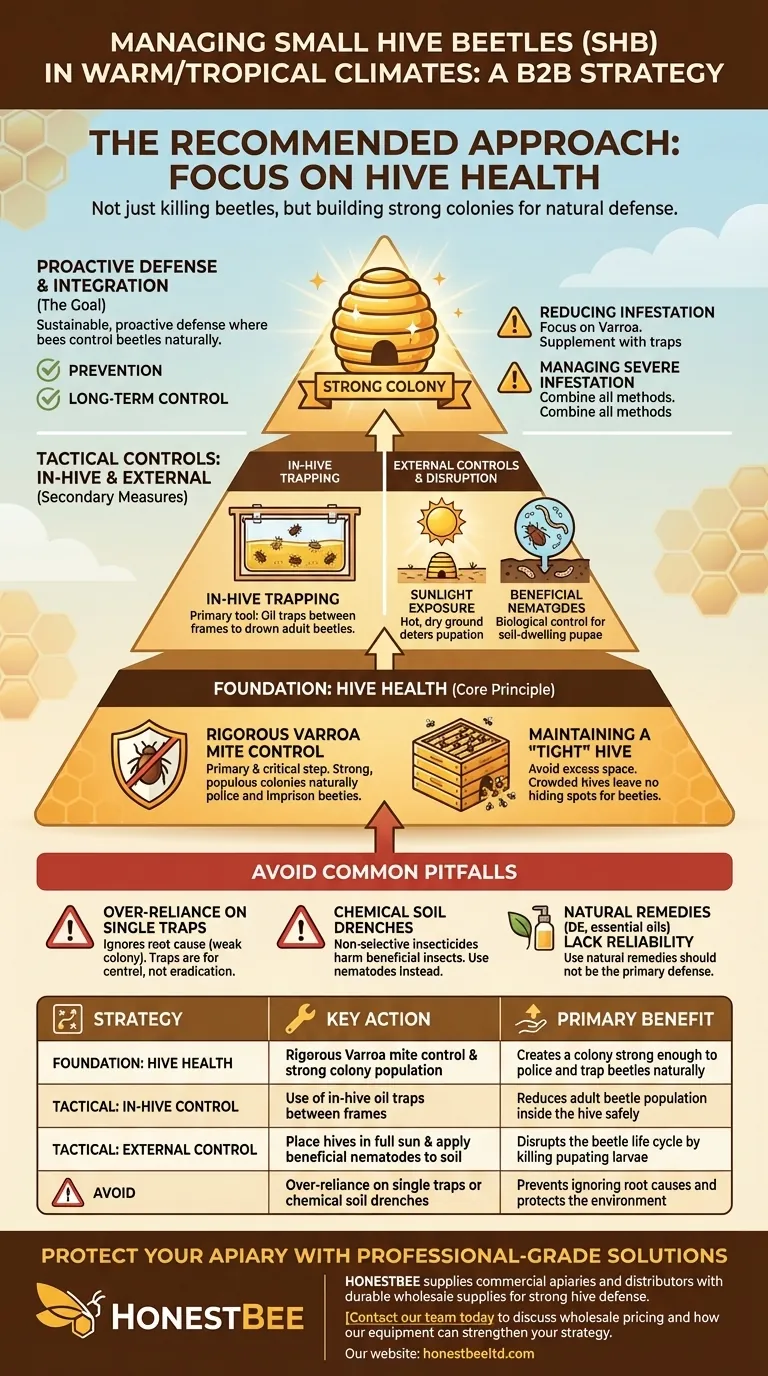The most effective strategy for managing small hive beetles (SHB) in warm and tropical climates is not a single trap or chemical, but a comprehensive focus on hive health. The primary and most critical step is maintaining low levels of Varroa mites, as a strong, populous colony is fully capable of defending itself against beetles. Traps and environmental controls serve as important secondary measures to support a healthy hive.
The core problem is not the beetle itself, but the underlying weakness in a hive that allows an infestation to take hold. Therefore, your focus should shift from simply killing beetles to cultivating a colony so strong that it can police and control them on its own.

The Core Principle: A Strong Colony is Your Best Defense
The foundation of any successful small hive beetle strategy is a robust, healthy, and populous bee colony. Weak hives are a breeding ground for beetles; strong hives are a fortress against them.
Why Hive Strength Matters
A colony with a large population of adult bees has the workforce necessary to manage pests. These "guard" bees will actively chase, capture, and imprison small hive beetles in propolis "jails," effectively neutralizing them before they can reproduce. A small or dwindling colony simply lacks the numbers to perform this critical defensive behavior.
The Critical Varroa Mite Connection
The Varroa destructor mite is the single greatest contributor to colony weakness and, consequently, to severe SHB infestations. Varroa mites feed on the fat bodies of bees, suppressing their immune systems and transmitting viruses. A hive struggling with Varroa is sick, stressed, and unable to mount an effective defense against the opportunistic small hive beetle. Controlling Varroa is controlling the gateway for beetles.
Maintaining a "Tight" Hive
Beetles thrive in dark, unoccupied spaces where bees cannot patrol. Avoid giving your colony more space (extra boxes or frames) than they can realistically cover and defend. A crowded, "tight" hive leaves no empty corners for beetles to hide and lay eggs.
Tactical Controls: A Multi-Layered Approach
While hive strength is your strategy, specific tactics are still required to reduce beetle pressure. The best results come from using multiple methods that target the beetle at different stages of its life cycle.
In-Hive Trapping: The Primary Tactical Tool
The most effective and widely used tactical control is the in-hive oil trap. These simple devices are designed to be placed between frames or on the bottom board. Beetles, seeking to evade the bees, run into the traps and drown in the non-toxic mineral oil or vegetable oil.
External Controls: Disrupting the Life Cycle
The SHB life cycle includes a crucial phase where larvae exit the hive to pupate in the surrounding soil. Attacking them here can significantly reduce future beetle populations.
- Sunlight: Placing your hives in direct, full sun is a powerful deterrent. SHB larvae require moist, shady soil to pupate successfully. Hot, dry ground is inhospitable to them.
- Beneficial Nematodes: These are microscopic organisms that can be applied to the soil around your hives. They actively hunt and kill pupating beetle larvae, providing a targeted, biological control without harming the bees.
Physical Barriers and Other Traps
Other mechanical options exist, though their effectiveness can vary. Beetle Baffles are devices that fit on the legs of a hive stand to prevent beetles from crawling up into the hive. Swiffer-type sheets, when placed inside the hive, can entangle the spiny legs of the beetles, trapping them.
Understanding the Trade-offs and Common Pitfalls
Relying on a single solution is a common mistake. An effective integrated pest management (IPM) plan requires understanding the limitations of each tool.
The Limits of Traps
Traps are for control, not eradication. They catch beetles but do not address the root cause of an infestation, which is almost always a weak or struggling colony. Over-reliance on trapping while ignoring hive health is a losing battle.
Chemical Soil Drenches
While products like Gardstar are labeled for drenching the soil to kill pupating beetles, they are potent insecticides. They are not selective and will kill beneficial insects and soil life, potentially causing wider environmental harm. Beneficial nematodes are a much safer and more targeted alternative for soil treatment.
The "Natural" Remedy Question
Remedies like diatomaceous earth (DE) and essential oils are often discussed but lack the reliability of proven methods. DE can be harmful to bees if it becomes airborne, and the efficacy of essential oils as a primary control method is not well-established. They should not be relied upon as your main line of defense.
Making the Right Choice for Your Goal
Your approach should be proactive and integrated, always prioritizing the health of the colony as the primary defense mechanism.
- If your primary focus is prevention and long-term control: Make rigorous Varroa mite management and maintaining strong, populous colonies your absolute top priority.
- If your primary focus is reducing an existing, minor beetle population: Supplement your hive health strategy with in-hive oil traps and ensure your hives are located in full sun.
- If your primary focus is managing a severe infestation: Combine all methods. Use in-hive oil traps to reduce adult beetle numbers inside the hive while applying beneficial nematodes to the soil outside the hive to break their life cycle.
Ultimately, understanding the biology of the small hive beetle and the central role of colony health empowers you to move beyond reactive trapping and toward a sustainable, proactive defense.
Summary Table:
| Strategy | Key Action | Primary Benefit |
|---|---|---|
| Foundation: Hive Health | Rigorous Varroa mite control & strong colony population | Creates a colony strong enough to police and trap beetles naturally |
| Tactical: In-Hive Control | Use of in-hive oil traps between frames | Reduces adult beetle population inside the hive safely |
| Tactical: External Control | Place hives in full sun & apply beneficial nematodes to soil | Disrupts the beetle life cycle by killing pupating larvae |
| Avoid | Over-reliance on single traps or chemical soil drenches | Prevents ignoring root causes and protects the environment |
Protect Your Apiary with Professional-Grade Solutions
Managing small hive beetles effectively requires a comprehensive strategy and the right equipment. HONESTBEE supplies commercial apiaries and beekeeping equipment distributors with the durable, wholesale-focused supplies needed to maintain strong, healthy hives.
We provide the essential tools for integrated pest management, from Varroa control treatments to reliable in-hive beetle traps. Let us help you build a more resilient and productive operation.
Contact our team today to discuss wholesale pricing and how our equipment can strengthen your hive defense strategy.
Visual Guide

Related Products
- Plastic Beetle Blaster Trap Beekeeping Tools and Supplies
- Reusable Clear Small Hive Beetle Traps for Beehives Beetle Trapping Tools
- Removable Washable Hive Beetle Trap Attractants for Small Hive Beetles
- HONESTBEE Advanced Ergonomic Stainless Steel Hive Tool for Beekeeping
- HONESTBEE Professional Multi-Functional Hive Tool with Ergonomic Wood Handle
People Also Ask
- What is the primary function of Beetle Blasters? Control Small Hive Beetles Effectively
- How can the effectiveness of Beetle Blasters be improved? Achieve Flawless Placement for Maximum SHB Control
- How do beetle blasters work to protect bee colonies? Effective IPM for Healthy Hives
- What is the purpose of the small hive beetle tray? A Non-Chemical Pest Control Solution
- What are the steps for installing hive beetle traps? A Guide to Effective Beetle Control



















